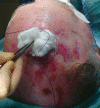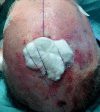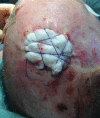The Running Barbed Tie-over Dressing
- PMID: 25289330
- PMCID: PMC4174211
- DOI: 10.1097/GOX.0000000000000078
The Running Barbed Tie-over Dressing
Abstract
Barbed suture technology is becoming increasingly popular in plastic surgery and is now being used in body contouring surgery and facial rejuvenation. We describe the novel application of a barbed suture as a running tie-over dressing for skin grafts. The barbs act as anchors in the skin, so constant tensioning of the suture is not required. The bidirectional nature of the suture prevents any slippage, and the barbs even act as a grip on the underlying wool dressing. Furthermore, the method described is both quick and simple to learn and would be useful for the sole operator.
Figures




References
-
- Rosen AD. New and emerging uses of barbed suture technology in plastic surgery. Aesthet Surg J. 2013;33(3 Suppl):90S–95S. - PubMed
-
- Zaruby J, Gingras K, Taylor J, et al. An in vivo comparison of barbed suture devices and conventional monofilament sutures for cosmetic skin closure: biomechanical wound strength and histology. Aesthet Surg J. 2011;31:232–240. - PubMed
-
- Joyce CW, Whately KW, Chan JC, et al. Flexor tendon repair: a comparative study between a knotless barbed suture repair and a traditional four-strand monofilament suture repair. J Hand Surg (Eur) 2013;44:1636–1639. - PubMed
-
- Pelissier P, Martin D, Baudet J. The running tie-over dressing. Plast Reconstr Surg. 2000;106:1436–1437. - PubMed
LinkOut - more resources
Full Text Sources
Other Literature Sources
Miscellaneous
